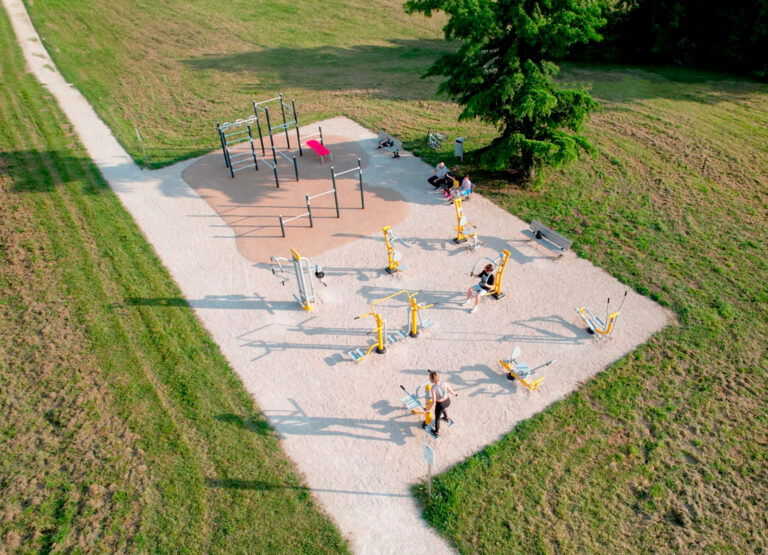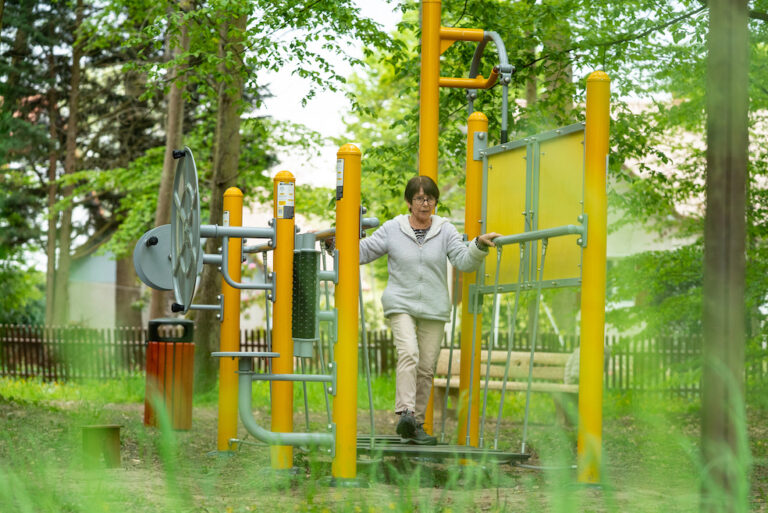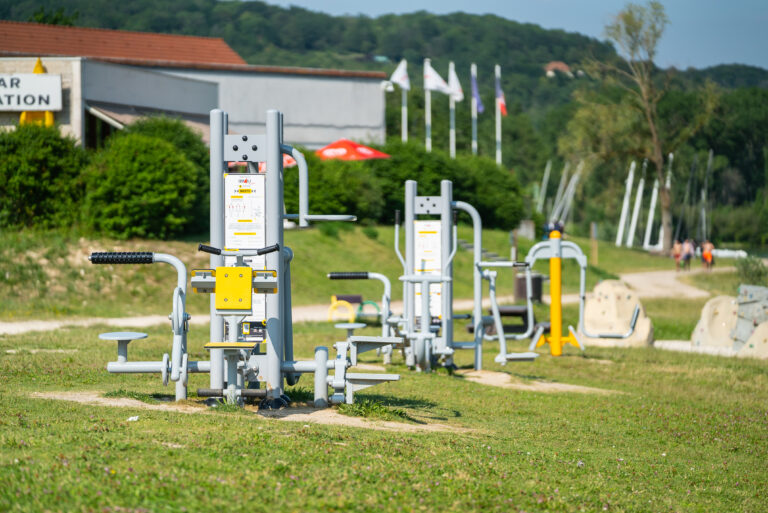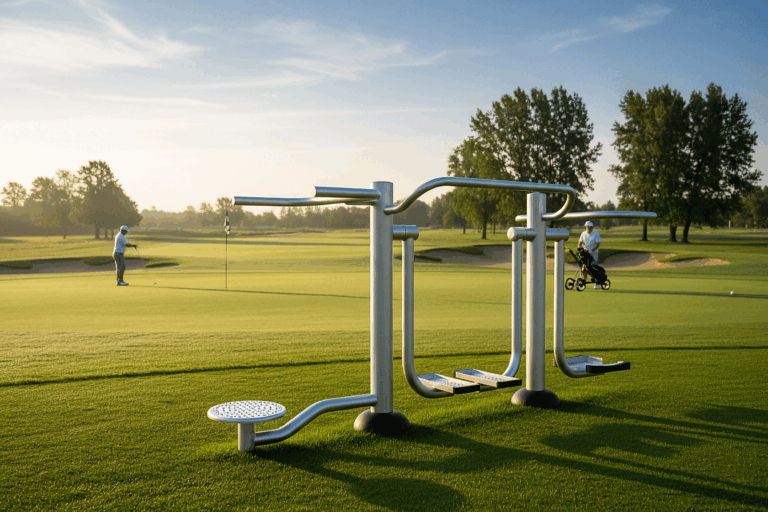In many cities, technical departments and design offices are faced with the same equation: how to encourage residents to walk or cycle more, while improving their health and enhancing the value of public space?
The outdoor fitness trail is gradually emerging as a relevant response to the triptych active mobility – sport – public health.
Unlike traditional sports facilities, which are confined to gymnasiums or stadiums, outdoor fitness trails can be integrated directly into the paths of everyday life: soft links, parks, riverbanks, the outskirts of campuses or residential areas. For a design office, it’s no longer just a question of “placing equipment”, but of designing a genuine urban development tool, capable of supporting a policy of active mobility, reducing sedentary lifestyles and boosting the attractiveness of the community.
In this article, we’ll look at why and how to integrate an outdoor fitness trail into an urban mobility plan, providing concrete keys for public space and green space designers.

Why integrate an outdoor fitness trail into an urban mobility plan?
The integration of an outdoor fitness trail into an urban mobility plan goes far beyond the simple creation of a sports area. It’s a cross-functional tool for mobility, health and social cohesion.
The transition from sport to active mobility: a modern urban strategy
Public policies are changing: we’re no longer just talking about “doing sport”, but about moving more on a daily basis. For town halls and design offices alike, this means designing spaces that naturally encourage walking, cycling and active travel.
In this context, the outdoor fitness trail is particularly interesting because it :
- is deployed along everyday routes (commuting, access to schools, public transport, cultural facilities);
- invites users to take a break from their journey to perform a simple exercise: stepper, pull-up, bike, dips, etc. ;
- adds a playful, visible dimension to active mobility, making it even more popular.
Where a bicycle path or landscaped sidewalk already encourages walking and cycling, adding an outdoor fitness trail takes it a step further: transforming a simple commute into an opportunity for structured physical activity, without the constraints of registration, schedules or cost.
For a design office, the integration of an outdoor fitness trail can therefore become a strong argument in a diagnosis or orientation report: public space is no longer just a place of transit, but a space for putting the body into motion.
The outdoor fitness trail as a public health tool
A sedentary lifestyle is now considered a major public health issue. Local health plans, regional programs and national policies encourage local authorities to promote regular physical activity, particularly for those who are farthest from traditional sports facilities.
An outdoor fitness trail offers several advantages:
- Free access: no economic, social or administrative barriers.
- Proximity: installed where residents already pass by, it reduces the disincentive to travel to a sports facility.
- Independent use: the equipment is intuitive and designed to be accessible to a wide audience.
- Frequency of use: located on daily commutes, the outdoor fitness trail encourages regular use, even for short periods (5 to 15 minutes).
For a design office, the health argument is important when drafting scoping notes, territorial diagnoses or responses to invitations to tender. Positioning an outdoor fitness trail as a tool for combating sedentary lifestyles and promoting independent exercise is one way of meeting the growing expectations of a local authority’s health, sport and social services.
Creation of self-service sports facilities
One of the main advantages of the outdoor fitness trail is its accessibility:
- no reservations,
- no staff to mobilize,
- no badge or registration,
- no specific sportswear required.
This logic of open-access sports is totally in line with public policies aimed at opening up the practice of sport to as many people as possible: young people, working people, senior citizens, families, tourists, etc.
For designers, this means that an outdoor fitness trail can be presented as a natural extension of the public space: just like a bench, a tree or lighting, sports furniture enriches the use of the area, without privatizing it or making it exclusive to one category of user.
This self-service dimension is particularly relevant to an urban mobility plan:
- A cyclist arriving a little early for an appointment can do a few exercises.
- A resident walking home can take 10 minutes to do some simple exercises on the way.
- A group of schoolchildren can use the equipment after class.
In other words, the outdoor fitness trail transforms a simple passing area into a space for active breaks, enhancing the attractiveness of the path.
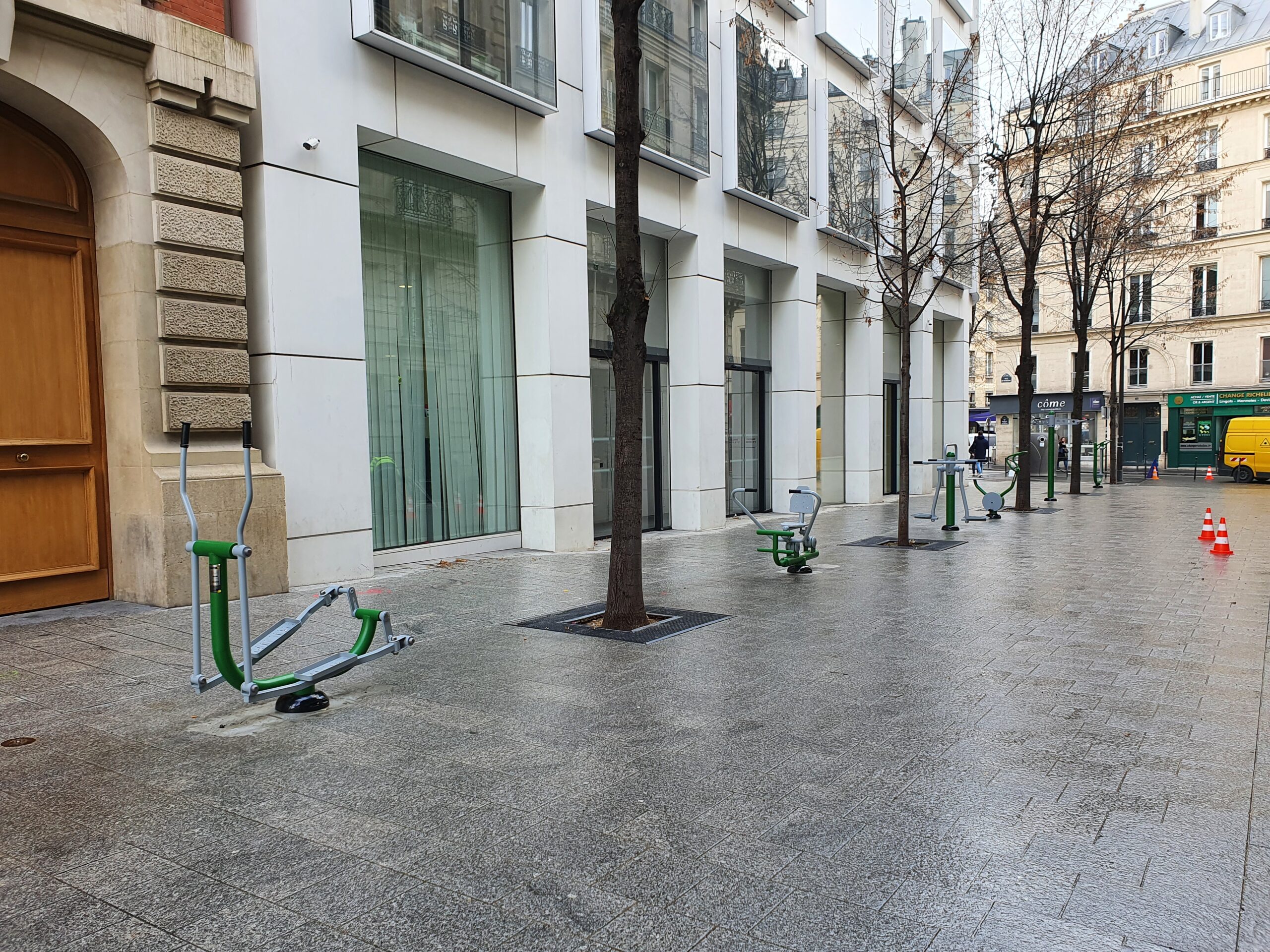
Outdoor fitness trails and active mobility: how to create urban connections?
For an outdoor fitness trail to play a real role in an urban mobility plan, it needs to be conceived as a link in the soft-travel network, not as an isolated area. The aim is to create continuity of use: I walk → I take a sports break → I continue my journey → I arrive at my destination more active and in better health.
The approach is therefore to integrate the outdoor fitness trail into existing urban flows, placing it in the right place, at the right time, for the right users.
Location along pedestrian and cycle paths
The priority is to locate the outdoor fitness trail on routes used on a daily basis, rather than in isolated, under-used areas, or those dedicated solely to leisure.
Good locations include :
- pedestrian links between residential areas and town centers;
- greenways, green corridors, urban promenades;
- cycling routes;
- school and campus pathways;
- suburban areas in transition to shopping centers, parks or public facilities.
This choice guarantees a high frequency of use, as it attracts users on the move – not just those who come on purpose to play sports.
⬥ Concrete example for a CCTP →
In the layout section, specify: “The outdoor fitness trail stations will be positioned less than 150 m from a soft traffic route recording more than 500 passages/day.”
Integration into a green and blue grid
Many communities are developing ecological corridors linking parks, natural areas, riverbanks and wooded areas. These spaces, often pedestrian and cycle-friendly, are ideal for installing an outdoor fitness trail because :
- they reinforce the idea of well-being and nature;
- they offer space for sports furniture;
- they are often already designed as active walking areas.
An outdoor fitness trail within this framework promotes soft mobility + physical activity + biodiversity, a strong triptych in modern public policies.
⬥ To be integrated into a project proposal →
“The outdoor fitness trail integrates into the green weave enabling ecological continuity while reinforcing the corridor’s sporting use.”
Synergy between outdoor fitness trails and urban running circuits
Today, running trails are a ubiquitous feature of our cities: landscaped quays, parks and urban forest paths. A outdoor fitness trail can structure these routes by adding :
- warm-up points,
- muscle-strengthening zones,
- recovery stations,
- complementary cardio modules.
The aim: to transform a simple running route into a complete sports course.
For a design office, this approach means that we can offer a hybrid solution, suitable for a variety of audiences: joggers, walkers, families, street sports enthusiasts, etc.
⬥ Example of a sequence in an urban plan →
Station 1: Bike + stepper → Station 2: dips + abs → Station 3: stretching.
This progressive structuring makes the outdoor fitness trail more intuitive and coherent in its use.
Outdoor fitness trails: which equipment to choose, depending on the urban context?
An outdoor fitness trail is not a one-size-fits-all model; it must be designed according to the location in which it is to be installed and the intended uses. The role of the design office is to adapt the stations and equipment to the urban context, user flows and active mobility objectives.
Below are four common types of layout, with equipment recommendations.
Fast transit zones: cardio stations and short modules
In places where people move quickly – commuting, urban pedestrian zones, transport exits – the aim is to offer simple, fast and intuitive exercises.
Examples of adapted equipment:
Expected features :
- small footprint,
- short use (2 to 5 min),
- to invite you to make an impromptu stop.
These facilities make the outdoor fitness trail an active break integrated into the journey, without the need for a full session.
Seine banks, parks and nature areas: complete strength + cardio courses
Parks, riverbanks and natural areas are ideal for prolonged exercise. Here, the outdoor fitness trail becomes a real circuit, complementing walking, running or cycling.
Recommended equipment :
Objective: to create a mixed course, providing a complete workout (endurance + strengthening + mobility).
BE constraints :
- landscape integration (choice of materials, colors),
- preservation of natural spaces,
- installation outside flood zones if on river banks.
Residential areas: health modules, seniors, sport-health
In residential areas, the main issue isintergenerational accessibility. The outdoor fitness trail must enable :
- back in motion,
- health prevention,
- gentle practice,
- light rehabilitation.
Adapted equipment :
Here, the interest is social: to create a space where families, teenagers, senior citizens and local associations can meet without physical or technical barriers.
Designing an outdoor fitness trail: steps for designers
Designing an outdoor fitness trail involves much more than simply choosing equipment. It’s a structured process, integrating territorial analysis, flow ergonomics, safety, environment, budget and maintenance.
Here are the key stages to follow to guarantee a coherent, sustainable and relevant project for a community.
Analysis of the territory and travel flows
The first step is to understand where and how people move around. The outdoor fitness trail must be set up in a strategic location, where it will spontaneously find its audience.
Data to be analyzed :
- pedestrian and bicycle flows (count, direction, intensity)
- generator centers (schools, train stations, public facilities)
- green spaces and ecological corridors
- visibility and a feeling of safety
- current urbanization and future projects
The aim was to position the outdoor fitness trail where it was already used, rather than creating an off-center facility requiring dedicated travel.
Population analysis (users, ages, needs)
Each region has its own specific characteristics: student town, residential community, seaside resort, rural area, priority district, tourist sector, etc.
For an outdoor fitness trail to be relevant, it must meet the real needs of the population:
| Type of audience | Priority needs | Recommended adaptation |
|---|---|---|
| Seniors | mobility, balance, health | soft equipment, seats, PMR walkways |
| Students / athletes | performance & challenge | street workout, strength modules |
| Families | fun & versatile | mixed stations, open spaces |
| Assets | quick practice | cardio + short exercises |
| Tourists / leisure | discovery & nature | panoramic route + educational panels |
➡ An effective outdoor fitness trail needs to mix intensity levels to reach multiple audiences.
Soil control, foundations, green spaces and lighting
The technical environment plays a major role in the durability and safety of the outdoor fitness trail.
Points to anticipate in the plans :
✔ stabilized soil or permeable slabs
✔ draining materials in wet areas
✔ foundations adapted to the type of equipment
✔ low-consumption LED lighting for night-time use
✔ tree management, roots and ecological impact
✔ perimeter furniture (benches, fountains, shade, signage)
Special cases :
- river bank → flood-prone ground → stainless steel materials and reinforced anchors required
- urban forest → little natural light → lighting essential
- sports perimeter → possibility of “soft floor” covering depending on use
An outdoor fitness trail is more popular when it’s visible, accessible and enjoyable.
Integration into a DCE or CCTP: key elements to be drafted
To help a local authority launch a call for tenders, the design office must structure the contractual documents by clearly defining :
📌 Project objectives and context
📌 Applicable standards (EN 16630, NF S52-909….)
📌 Material criteria and durability
📌 Typology of layout and technical constraints
📌 Execution drawings and exact layout
📌 PMR accessibility requirements
📌 Maintenance criteria and guarantees
📌 Expectations regarding pedagogy (signs, pictograms, autonomous use)
Standard sentence to insert :
“Outdoor fitness course equipment must be designed for free-access use, without mechanisms, adapted to the outdoor environment, and guaranteed against corrosion for a minimum of 10 years.”
This structuring reinforces the quality of the market and avoids low-end or inconsistent responses.
Conclusion: why is the outdoor fitness trail a key tool for the urban future?
The outdoor fitness trail has established itself as a modern response to the intersecting challenges facing cities: active mobility, public health, urban appeal and sustainable development. By transforming daily commutes into opportunities for spontaneous physical activity, it goes beyond a simple sporting logic to become part of a global vision of public space.
For local authorities, this type of development offers several decisive advantages:
- Encourage unrestricted physical activity, particularly among people who are far removed from traditional sports;
- support soft mobility policies, by making walking and cycling more attractive;
- enhance the value of public spaces by creating meeting points, places for relaxation and shared use;
- Reduce the overall cost of sport with robust, open-access, mechanism-free equipment;
- reinforce the image of an active, sustainable city focused on the well-being of its residents.
For design offices, integrating an outdoor fitness trail into an urban mobility plan enables them to propose a cross-disciplinary project, capable of meeting the needs of several municipal departments (sport, health, urban planning, green spaces, tourism, social) and providing tangible added value to calls for tender.
In a nutshell:
The outdoor fitness trail is more than just a sports facility: it’s a strategic tool for urban development, promoting active mobility and public health.
Cities wishing to promote a more active lifestyle, reduce sedentary lifestyles and create more attractive public spaces have every interest in integrating this type of facility into their urban strategy.

